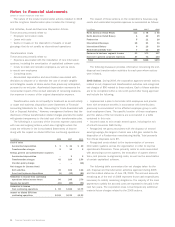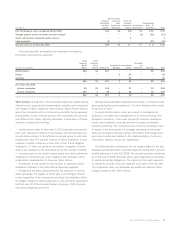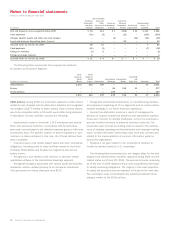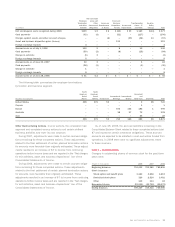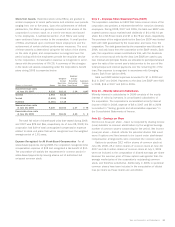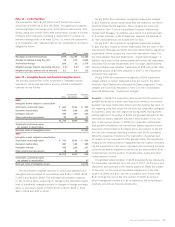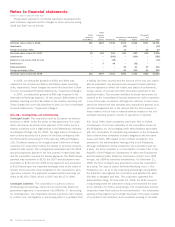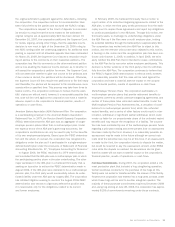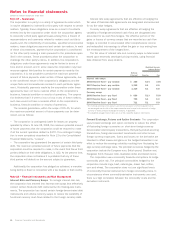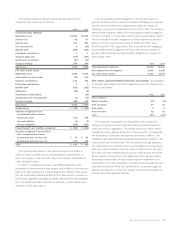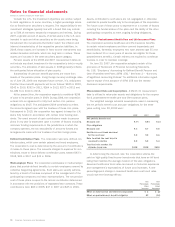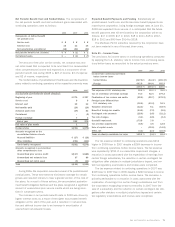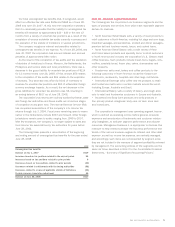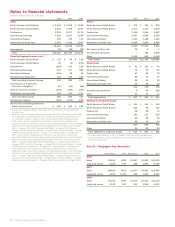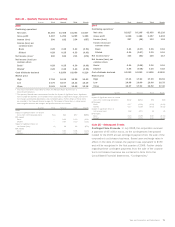Sara Lee 2008 Annual Report Download - page 68
Download and view the complete annual report
Please find page 68 of the 2008 Sara Lee annual report below. You can navigate through the pages in the report by either clicking on the pages listed below, or by using the keyword search tool below to find specific information within the annual report.
Notes to financial statements
Dollars in millions except per share data
Note 17 – Guarantees
The corporation is a party to a variety of agreements under which
it may be obligated to indemnify a third party with respect to certain
matters. Typically, these obligations arise as a result of contracts
entered into by the corporation under which the corporation agrees
to indemnify a third party against losses arising from a breach of
representations and covenants related to matters such as title to
assets sold, the collectibility of receivables, specified environmental
matters, lease obligations assumed and certain tax matters. In each
of these circumstances, payment by the corporation is conditioned
on the other party making a claim pursuant to the procedures spec-
ified in the contract. These procedures allow the corporation to
challenge the other party’s claims. In addition, the corporation’s
obligations under these agreements may be limited in terms of
time and/or amount, and in some cases the corporation may have
recourse against third parties for certain payments made by the
corporation. It is not possible to predict the maximum potential
amount of future payments under certain of these agreements, due
to the conditional nature of the corporation’s obligations and the
unique facts and circumstances involved in each particular agree-
ment. Historically, payments made by the corporation under these
agreements have not had a material effect on the corporation’s
business, financial condition or results of operations. The corpora-
tion believes that if it were to incur a loss in any of these matters,
such loss would not have a material effect on the corporation’s
business, financial condition or results of operations.
The material guarantees, within the scope of FIN 45, for which
the maximum potential amount of future payments can be deter-
mined, are as follows:
•The corporation is contingently liable for leases on property
operated by others. At June 28, 2008, the maximum potential amount
of future payments that the corporation could be required to make
if all the current operators default is $172. This contingent obliga-
tion is more completely described in Note 13 to the Consolidated
Financial Statements, “Leases”.
•The corporation has guaranteed the payment of certain third-party
debt. The maximum potential amount of future payments that the
corporation could be required to make, in the event that these third
parties default on their debt obligations, is $32. At the present time,
the corporation does not believe it is probable that any of these
third parties will default on the amount subject to guarantee.
Additionally, the corporation has pledged as collateral, a manufac-
turing facility in Brazil in connection with a tax dispute in that country.
Note 18 – Financial Instruments and Risk Management
Interest Rate and Currency Swaps To manage interest rate risk,
the corporation has entered into interest rate swaps that effectively
convert certain fixed-rate debt instruments into floating-rate instru-
ments. The corporation has issued certain foreign-denominated debt
instruments and utilizes currency swaps to reduce the variability of
functional currency cash flows related to the foreign currency debt.
Interest rate swap agreements that are effective at hedging the
fair value of fixed-rate debt agreements are designated and accounted
for as fair value hedges.
Currency swap agreements that are effective at hedging the
variability of foreign-denominated cash flows are designated and
accounted for as cash flow hedges. The effective portion of the
gains or losses of currency swaps that are recorded as cash flow
hedges is recorded in accumulated other comprehensive income
and reclassified into earnings to offset the gain or loss arising from
the remeasurement of the hedged item.
The fair value of interest rate and currency swaps is determined
based upon externally developed pricing models, using financial
data obtained from swap dealers.
Weighted Average
Interest Rates 2
Notional
Principal 1Receive Pay
Interest rate swaps
2008 Receive fixed – pay variable $÷«385 5.3% 3.5%
2007 Receive fixed – pay variable 1,315 5.1 6.0
2006 Receive fixed – pay variable 1,316 5.1 5.8
Currency swaps
2008 Receive fixed – pay fixed $÷«886 5.1% 5.0%
2007 Receive fixed – pay fixed 755 5.1 5.0
2006 Receive fixed – pay fixed 711 5.1 5.0
1The notional principal is the amount used for the calculation of interest payments that
are exchanged over the life of the swap transaction and is equal to the amount of foreign
currency or dollar principal exchanged at maturity, if applicable.
2The weighted average interest rates are as of the respective balance sheet dates.
Forward Exchange, Futures and Option Contracts The corporation
uses forward exchange and option contracts to reduce the effect
of fluctuating foreign currencies on short-term foreign-currency-
denominated intercompany transactions, third-party product-sourcing
transactions, foreign-denominated investments and other known
foreign currency exposures. Gains and losses on the derivative are
intended to offset losses and gains on the hedged transaction in an
effort to reduce the earnings volatility resulting from fluctuating for-
eign currency exchange rates. The principal currencies hedged by the
corporation include the European euro, British pound, Brazilian real,
Hungarian forint, Russian ruble, Australian dollar and Danish krone.
The corporation uses commodity forwards and options to hedge
commodity price risk. The principal commodities hedged by the
corporation include hogs, beef, natural gas, diesel fuel, coffee,
corn and wheat. The corporation does not use significant levels
of commodity financial instruments to hedge commodity prices. In
circumstances where commodity-derivative instruments are used,
there is a high correlation between the commodity costs and the
derivative instrument.
66 Sara Lee Corporation and Subsidiaries


